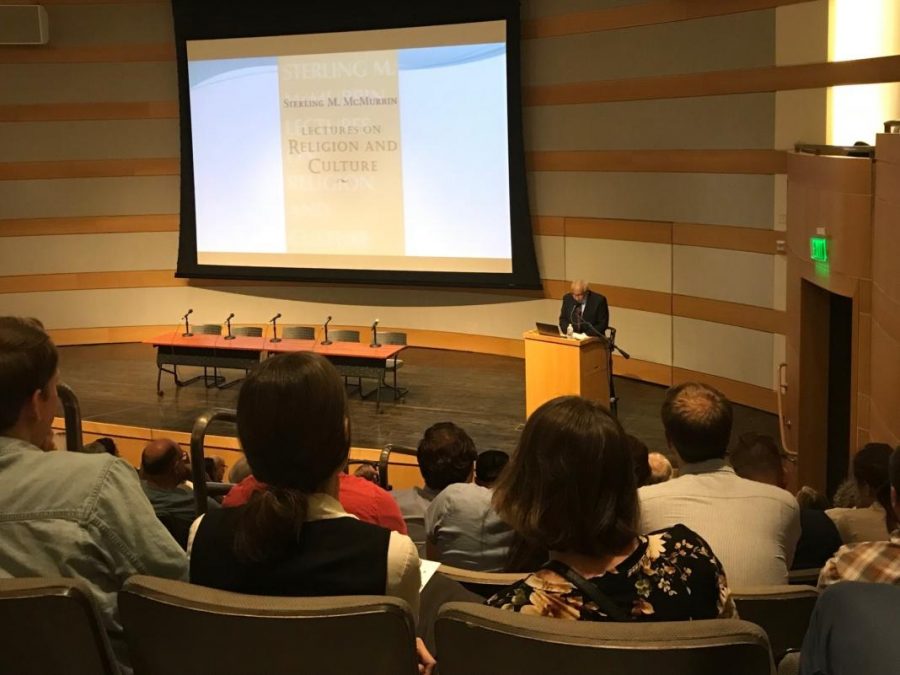Speaking to when he heard about the revelation in 1978 that black men who were members of the Church of Jesus Christ of Latter-day Saints would receive the priesthood, Darius Gray said, “I couldn’t believe it when it was first told me … when it was confirmed I was excited beyond belief.”
This year, the LDS church celebrated the 40th anniversary of former President Spencer W. Kimball’s revelation, which has prompted members to ask whether the church has achieved racial equality and what barriers black members still confront in finding acceptance and community in the faith.
To facilitate dialogue around the issue, the University of Utah’s Tanner Humanities Center organized “Black, White and Mormon II: A Conference on Race in the LDS Church Since the 1978 Revelation” from June 29 to June 30 at the Salt Lake City Public Library. The symposium was put together in collaboration with Paul Reeve — the College of Humanities’ first Mormon studies professor appointed last year. It is a continuation of a conference that the center hosted in 2015 surrounding race in the LDS church.
Gray’s “A 54-Year Journey Toward Racial Equality in the Mormon Church” was the keynote and this year’s Sterling M. McMurrin Lecture on Religion and Culture. Darius Gray served from 1997 to 2003 as the president of the Genesis Group of the LDS church, a branch established by church leadership in 1971 to support African-American members, of which he is also a founding member.
When Gray was asked by Tanner Humanities Center Director Robert Goldberg to speak on race in the church, he said he responded in an email, “Hello Bob, Yes, yes, yes, I accept!” But as he researched the historic and current treatment of many black members of the faith, Gray said his enthusiasm diminished.
As he worked on his speech, Gray was also writing an article for the church’s Ensign, an official periodical magazine with faith-promoting content. The piece first appeared on the church’s blog in April.
“Some have felt the sting of being considered ‘the other’ or ‘the lesser,'” Gray wrote. “It seems to me that such attitudes have increased in the world around us in recent years, perhaps due in part to the vitriolic language that has come to permeate political speech in various nations around the globe. Nothing could be further from the teachings of Jesus Christ than for any human being to think of himself or herself as somehow superior to another human being based upon race, sex, nationality, ethnic origins, economic circumstances, or other characteristics.
In the address, Gray recounted anecdotes shared with him by black members who have experienced many forms and degrees of racism in recent years. He then reviewed faith-based literature which showed dark views on race held by church members in years past.
“Seventy’s Course in Theology,” a series of five books written by former Quorum of the Seventy President Brigham H. Roberts beginning in 1907, included the author’s beliefs on phrenology — the study of skull size, which was falsely linked to intelligence and used as a scientific justification for racism.
“That the Negro is markedly inferior to the Caucasian is proved both craniologically and by six thousand years of planet-wide experimentation; and the comingling of inferior with superior must lower the higher,” the book read.
Another cited example of historic racism in the church was an 1868 article in the Juvenile Instructor, a periodical for young members of the faith which later became an official church publication in 1901. It read, “Next in order stands the Negro race, the lowest in intelligence and the most barbarous of all the children of men.”
Gray said words like these poisoned the church with racism, and black members are still suffering the consequences today. Looking at the church’s history, Gray said, “We stand convicted for our lack of charity and Christ-centered love.”
When it comes to policies of the church, like blacks being banned from receiving the priesthood and entering the temple, Gray said only one video sequence published by the church has attributed the ban to God. While he believes that the policy is one that came from men, he said he has no intention of belittling or demeaning church leaders past or present.
“[They were] trying their best to do their best, and I don’t condemn them,” Gray said. “I wish they were more in tune with the spirit of God than they were.”
On June 1, nearly one month before Gray’s speech, the church held the “Be One” celebration to commemorate the revelation that lifted the priesthood ban. Gray said the event, one where LDS church President Russell M. Nelson condemned “walls of segregation,” renewed his hopes for the future.
“We cannot focus on the past,” Gray said. “We need to let the past teach us so we can move to the future.”
On Saturday, June 30, the conference was filled with community and academic panels from 9 a.m. to 5 p.m. This session opened with Paul Reeve’s unveiling of his database, “A Century of Black Mormons.” The database is a collection of information about every black member of the LDS church between 1830 and 1930, including biographies, baptisms and confirmations, and is available for free online.
“I have been excited about this for a very long time,” Reeve said. “In the months leading up to the 2012 presidential election between Barack Obama and Mitt Romney, a few media outlets reinforced the public perception that Mormons were predominantly white … Jimmy Kimmel asked on Jimmy Kimmel Live, ‘Are there black Mormons? I find that hard to believe.’ A new digital industry project, a Century of Black Mormons, is designed to not only answer such questions, but to historicize them.”
According to Reeve, until now, no scholar had attempted to name and number black Mormons in the early 19th and 20th centuries, allowing for “historical amnesia to dominate one of the nation’s homegrown religions.”
The panels that followed Reeve’s announcement discussed black Mormons from the early days of the church up until now.
Four panels focused on racial inequity, violence and whiteness in both the United States and the LDS church, racial issues in the church since the 1978 policy change, young black members’ experience growing up in an age without such a ban, and the intersection of church and community, as in situations like police brutality and national anthem protests. The conference closed with a “Cultural Celebration with Marj Desius,” a pop singer who is well known for her song covers and parodies in Spanish, Haitian Creole and French.
e.anderson@dailyutahchronicle.com
j.mumford@dailyutahchronicle.com




Benvindo Secuma • Jul 16, 2018 at 4:57 pm
As a black male Mormon from Africa (Angola), I feel happy that such issues are discussed openly by church members. We, black Mormons need to understand that our white brothers from everywhere in the world were mostly a product of their own times, and very few were able to overcome that devilish mind-set of the time. Let us thank God for letting the truth prevail. The Gospel is true, but we man are short at all times. Let us forgive and move forward! God bless!